|
|
|
|
|
|
|
|
|
|
|
|
|
|
Functional
Genome Analysis (B070)
Deutsches
Krebsforschungszentrum,
Im Neuenheimer Feld 580
D-69120
Heidelberg,
Germany. |

|
|
|
|
|
|
|
|
|
|
|
|
..
..
..
FINISHED
PROJECT:
Manufacturing
DNA-microarrays of high spot homogeneity and reduced background signal
from unpurified PCR-products
|
Diehl et al. (2002) Nucleic
Acids Res. 30, e79.
|
 |
|
Diehl et al. (2001) Nucleic
Acids Res. 29, e38.
|
 |
For
the production of DNA-microarrays from PCR-products, the purification
of the
DNA-fragments prior to spotting is a major expense in cost and time.
Also, a
considerable amount of material is lost during this process and
contamination
might occur.
We
developed a protocol that permits the manufacturing of microarrays from
unpurified PCR-products. The presence of primer molecules in the
PCR-sample
does not increase unspecific signal upon hybridisation. Overall, signal
intensity on arrays made of unpurified PCR-products is 94% of the
intensity
obtained with the respective purified molecules. This slight loss in
signal,
however, is offset by a reduced variation in the amount of DNA present
at the
individual spot positions across an array, apart from the considerable
savings
in time and cost. In addition, a larger number of arrays that can be
made from
one batch of amplification products.
By
using betaine as an additive to the spotting solution, both the binding
efficiency of spotted PCR-products and the homogeneity of the DNA-spots
is
improved significantly on aminated surfaces such as glass slides coated
poly-L-lysine or aminosilane. In addition, unspecific background signal
is
markedly diminished. Concomitantly, the betaine reduces evaporation
from the
microtitre dish wells during the arraying procedure.
Subsequent
blocking of the chip surface with succinic anhydride was improved in
presence
of the unpolar, non-aqueous solvent 1,2-dichloroethane and the
acylating
catalyst N-methylimidazole. This procedure prevents overall background
signal
that occurs with the frequently applied aqueous solvent
1-methyl-2-pyrrolidone
in borate buffer because of DNA that re-dissolves from spots during the
blocking process, only to bind again across the entire glass surface.
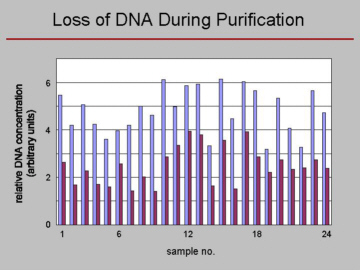
| Figure. The amount
of DNA present before (left bar) and after purification
(right bar) of 24 randomly chosen PCR products. On average, 49% of the
material
was lost during purification. |
|
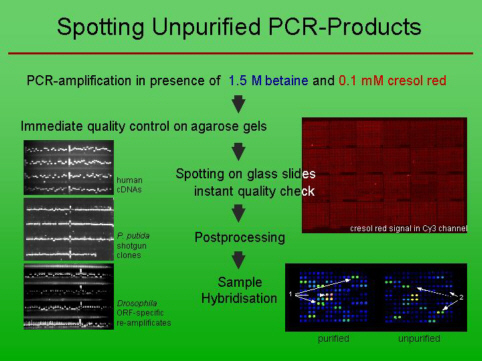
.
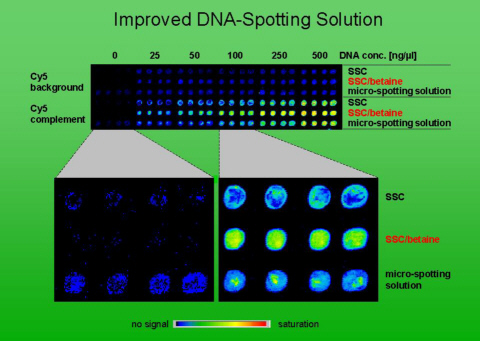
.
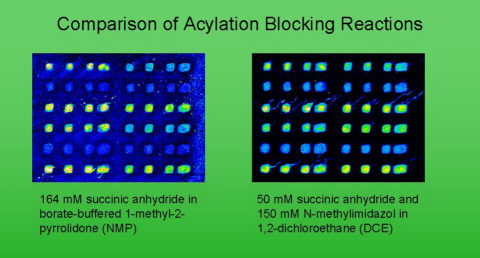
|
FINISHED PROJECT:
Quantitative
photolithographic synthesis of individually quality-checked DNA
microarrays

For DNA-chip
analyses,
oligonucleotide quality has immense consequences to accuracy,
sensitivity and
dynamic range. Quality of chips produced by photolithographic in
situ
synthesis depends critically on the efficiency of photo-deprotection.
By means
of base-assisted enhancement of this process using
5'-[2-(2-nitrophenyl)-propyloxycarbonyl]-2'-deoxynucleoside
phosphoramidites,
synthesis yields improved by at least 12% per condensation compared to
current
chemistries. Thus, the eventual total yield of full-length
oligonucleotide is
increased more than tenfold in case of 20-mers. Furthermore, the
quality of
every individual array position was checked quantitatively after
synthesis.
Subsequently, the very, quality-tested chips were used in successive
hybridisation experiments.
..
..
| Beier and Hoheisel
(1999) Nucleic Acids Res. 27, 1970-1977. |
 |
| Beier and Hoheisel
(2000) Nucleic Acids Res. 28, e11. |
 |
| Beier and
Hoheisel (2005) Curr.
Protocols Nucleic Acids Chem., unit 12.5. |
|
other
publications and patents
|
|
|
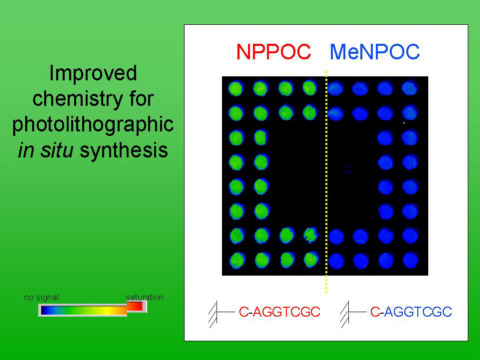 |
FINISHED PROJECT:
Photolabile
5'-O-phosphoramidites for the photolithographic production of
microarrays
of inversely oriented oligonucleotides

Photolabile
3'-O-[2-(2-nitrophenyl)propoxycarbonyl]-protected 5'-phosphoramidites
were
synthesised for an alternative mode of light-directed production of
oligonucleotide arrays. Because of the characteristics of these
monomeric
building blocks, photolithographic in situ DNA-synthesis occurs
in 5'-3'
direction, conform to the orientation of enzymatic synthesis. The
production of
such oligonucleotide chips adds new procedural avenues to the growing
number of
applications of DNA-microarrays.
..
| Beier et al.
(2001) Hel. Chim. Acta 84, 2089-2095. |
 |
|
| Beier
and Hoheisel (2002) J.
Biotechnol. 94, 15-22. |
 |
|
| Beier and Hoheisel
(2004) Curr. Protocols Nucl. Acids Chem., Unit 12.3. |
|
| Beier and
Hoheisel (2004) Curr.
Protocols Nucl. Acids Chem., Unit 12.4. |
|
.other
publications and patents |
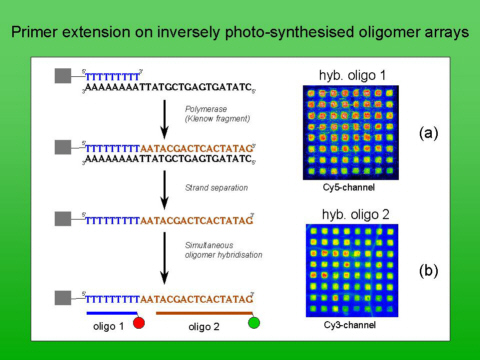 |
FINISHED PROJECT:
Label-free
and amplification-free detection
of microarray analyses by means of peptide nucleic acids (PNAs)

Important
aspects in
microarray analyses are the sensitivity and selectivity of the binding
of the
assayed DNA molecules. Since the studied DNA-samples usually require a
(PCR)
amplification and (fluorescence) labelling prior to analysis,
time-consuming
and costly preparative steps are required, which also might introduce
experimental biases. The structural difference between PNA – used as
probe on
the array – and a DNA-target permits a direct detection of the nucleic
acid by
mass spectrometry, a process that is much more sensitive than current
detection
techniques. Thereby, all the preparative steps could be avoided. Upon
hybridisation of a DNA or RNA sample to a PNA-array, the phosphates of
the
nucleid acids can be utilised as an intrinsic label for detection by
secondary
ion mass spectrometry (SIMS); PNA molecules are lacking phosphate
groups
entirely. In collaboration with Heinrich
Arlinghaus (University of Münster), we
were establising the processes for analysing genomic DNA directly
without the
need for amplification or labelling.
|
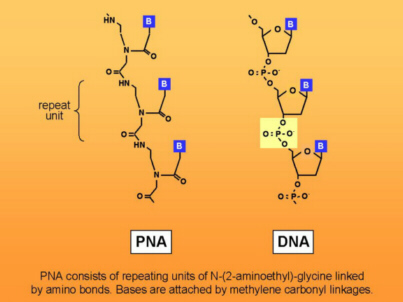 |
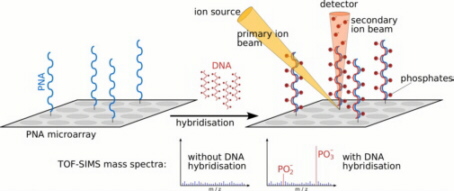 |
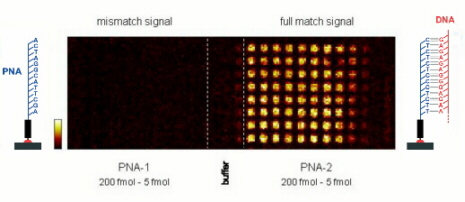 |
| Label-free
detection by TOF-SIMS analysis. A
primary ion beam hits the surface, from which secondary ions, including
phosphate fragments, are released. PNA does not contain phosphates.
Therefore, phosphate ionsare visible
in the mass spectrum of a PNA-microarray only upon hybridisation of
nucleic acids. |
SNP-typing
unlabelled DNA. A dilution series of two
different PNA oligomers was spotted left to right (spot diameter: 300
µm) in columns of eight copies
on a silicon wafer with gold-surface. Hybridisation was with an
unlabelled DNA
that was complementary to only the PNA on the right. Analysis was by
TOF-SIMS. The image is a
false-colour
representation of the signal intensities at a mass of 79 Da. |
..
...aaaaa
| Weiler et al.
(1997) Nucleic Acids Res. 25, 2792-2799. |
|
|
| Matysiak et al. (1999) Nucl. & Nucl. 18, 1289-1291. |
|
|
| Matysiak et al.
(2001) BioTechniques 31, 896-904. |
|
 |
| Brandt
et al.
(2003) Nucleic Acids Res. 31,
e119. |
|
 |
| Bauer
et al.
(2003) Comp. Funct. Genom. 4,
520-524. |
|
 |
| Jacob et al.
(2003) Peptide
Nucleic Acids
(Nielsen, P.E., ed.), 261-279. |
|
|
| Jacob
et al.
(2004) Methods in Mol. Biol. (Niemeyer,
C., ed.), 283-294. |
|
|
| Arlinghaus
et
al. (2004) Appl. Surface
Sci. 231-232, 392-396. |
|

|
|
|
|
|
| Brandt &
Hoheisel (2004) Trends
Biotechnol. 22, 617-622. |
|
 |
| Hellweg et
al. (2006) Appl. Surface Sci. 252,
6742-6745. |
|
 |
| Brandt et al.
(2006) Appl. Surface Sci. 252,
6935-6940. |
|
|
| Jacob et al.
(2006) Encyclop. Ref. Genomics Proteomics Mol. Med. (Ganten, D.
&
Ruckpaul, K., eds.), 1422-1425. |
|
 |
| Mraheil et
al. (2010) Microb. Biotechnol. 3, 634-657. |
|
|
-----------------------------------------------------------------
other
publications and patents |
|
|
|
|
|
|
|
..
..
|



